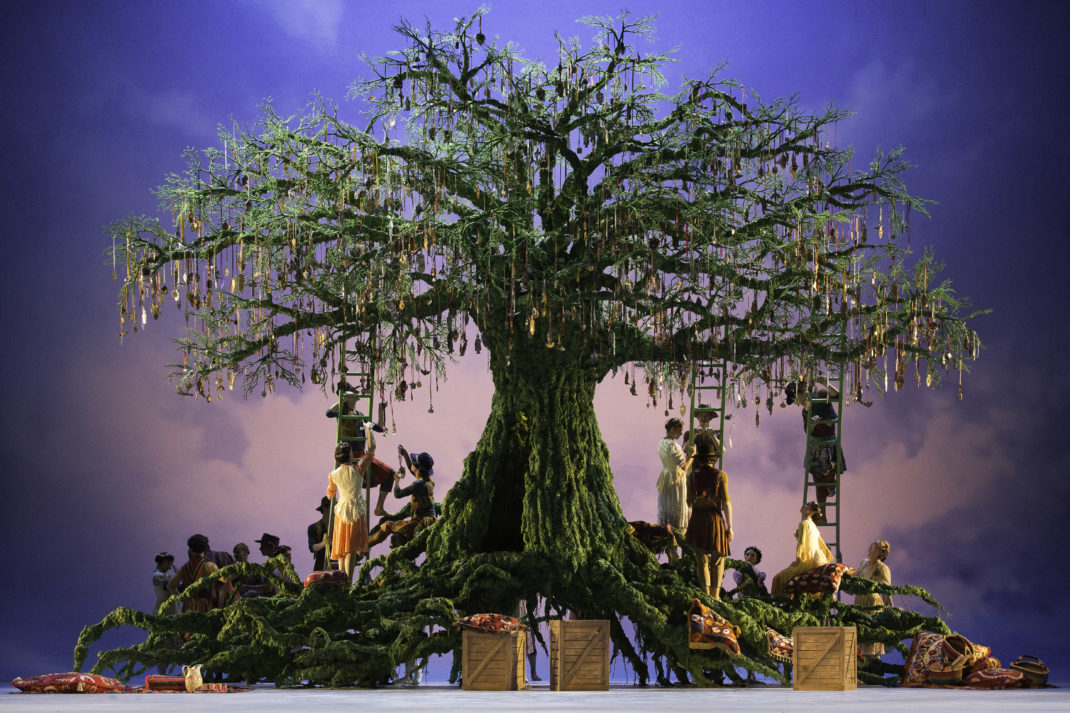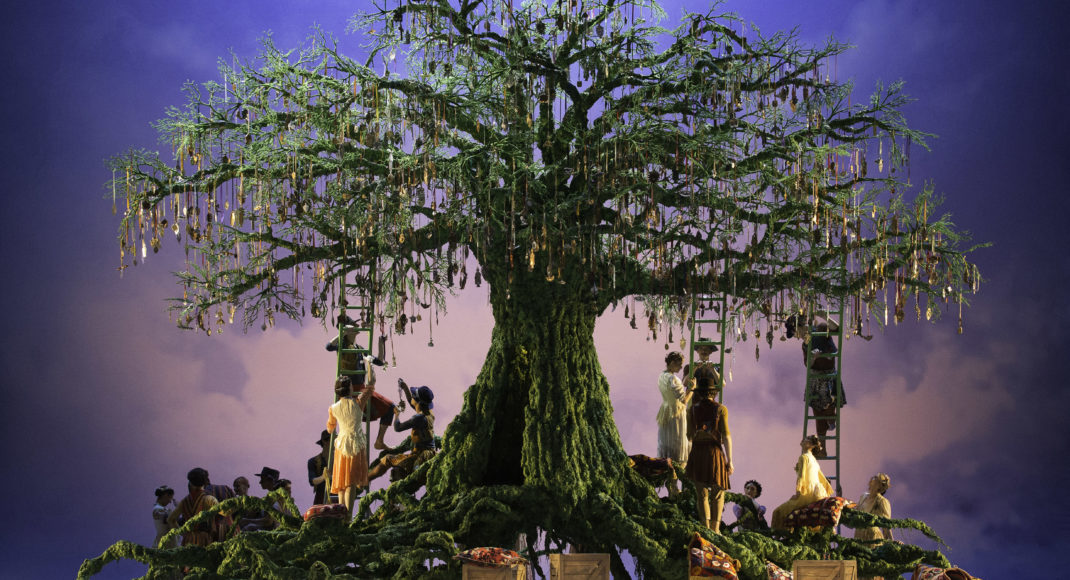6 July 2017 (matinee and evening), Lyric Theatre, Queensland Performing Arts Centre, Brisbane
There is much to admire about The Winter’s Tale, Christopher Wheeldon’s balletic translation of William Shakespeare’s play of the same name. For a start, the mood is often absolutely gripping—often in an ‘edge of the seat’ manner. It is also just brilliantly performed by artists of the Royal Ballet in both a technical sense, and in terms of the emotional involvement of everyone on stage. In addition, the visual effects, especially the use of designer Basil Twist’s painted silks that dropped down to indicate the sea or to allow for a change of place, were captivating, as was the use of film footage throughout.
It is a complex story about the relations between the Kings of Sicilia and Bohemia, the breakdown of their friendship and the final reconciliation, along with all the intrigue and jealousy, the sea journeys, and the chance occurrences that attend the breakdown. But the clarity with which the story unfolded was outstanding. That the story was so easily understood was partly as a result of the choreography and partly as a result of how Wheeldon had selected events from the play and added links between them. It was exhilarating to see, for example, how Wheeldon handled the passage of time before the events he had chosen to focus on had taken place. In the opening prologue we watched as two young princes, initially playing together, were replaced by two grown men. It was a simple ploy but so effective in showing, in addition to the passage of time, that the friendship between the two kings had developed since childhood, which is why we encounter them together in Act I in the palace of Leontes, King of Sicilia, initially enjoying each other’s company.
Act I was the strongest of the three acts and a clear highlight was the choreography for Leontes (Bennet Gartside, matinee and evening). When he began to suspect that the baby being carried by his pregnant wife, Hermione (Marianela Nuñez, matinee and evening), was not his but that of Polixenes, his friend and King of Bohemia, his rage and jealousy were expressed through angular movements, clenched hands, slinking movements, and depraved twists of the body.
Laura Morera (evening) gave a strong performance as Paulina, head of Hermione’s household, especially in her attack on Leontes as he banished Hermione, and when he could not bear to look at the newly born child, Perdita. Nuñez as Hermione danced with refinement and accepted her banishment with the grace and strength of a queen. I admired, too, the motherly affection she showed to her son Mamillius in the early stages of Act I.
But for me the standout performance in Act I came from Ryoichi Hirano (evening) as Polixenes. He held my attention from the moment he came on stage and I loved the way he executed the choreography, highlighting as he did the rather more eccentric choreography he was given as the King of Bohemia. In fact, his emphasis on those choreographic elements that seemed more folkloric than those given to the residents of Sicilia foreshadowed what was to take place in Act II, which was set in Bohemia. In addition, his duet with Hermione, as Leontes lurked in the background or peered from behind statues, was passionately danced and had sexual overtones to the extent that it made Leontes’ jealousy seem to have some basis in truth. Such movement by Hirano highlighted Gartside’s unsavoury loiterings and suggested what was going through Leontes’ mind.
In Act II the dancing didn’t falter. Beatriz Stix-Brunell (evening) as Perdita and Vadim Muntagirov (evening) as Florizel danced sumptuously, with Muntagirov soaring across the stage and sweeping Stix-Brunell off her feet (literally as well as figuratively). But again my attention was drawn to Hirano who made me smile as he attempted to disguise himself in shepherd’s clothing to spy on his son Florizel who was courting Perdita. That hat didn’t seem to fit his kingly head and he seemed a little bamboozled by it all.
Wheeldon’s choreography for the groups of shepherds and shepherdesses in this act was pleasant enough and certainly was in folkloric mode. But after such a powerful Act I, it seemed all too much like a traditional three-act ballet where at some stage everyone has to have a jolly good time.
Back in Sicilia in Act III, conflicts and concerns are resolved and there is eventually a marriage (I think—everyone was dressed in white) between Perdita and Florizel. But the most interesting part of this act concerned the return of Hermione, disguised at first as a statue. It made for an engaging re-connection between Hermione and Leontes, gently manouevered by Paulina. In fact there was a curious connection between Paulina and Leontes who seemed to lean on her (in fact choreographically he did lean on her) for support at the beginning of the act. But his contrition was made clear and he danced with Hermione in a final pas de deux.
As in Act II, the dancing in Act III was pretty much faultless and a pleasure to watch. But again it was Hirado as Polixenes who attracted my attention. I admired the way he stormed in looking for Florizel in order to drag him back to Bohemia and declined at first Leontes’ attempts at reconciliation, but then mellowed when he realised that Perdita had royal blood. It was a powerful performance from him from start to finish.
The Royal Ballet’s touring program presented audiences with an interesting juxtaposition of ballets. Both Woolf Works and The Winter’s Tale are contemporary (that is of today) productions but The Winter’s Tale remains within a certain traditional mode—a three-act narrative, moving along logically, and having some balletic predictability about its structure. On the other hand Woolf Works pushes boundaries and makes demands of us. We have to suspend many preconceived ideas about how to see and think about ballet. Both modes of presentation have a place but, while I sat transfixed by The Winter’s Tale, twice, what Wayne McGregor presented in Woolf Works is how I want dance to move ahead.
Michelle Potter, 9 July 2017
Featured image: Set for Act II, The Winter’s Tale. The Royal Ballet. Photo: © ROH/Johan Persson

